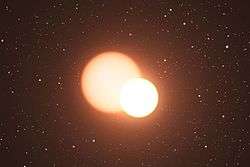OGLE-LMC-CEP0227
OGLE-LMC-CEP0227 is an eclipsing binary (Cepheid variable) star,[5] pulsating every 3.8 days.[6] The star, in the Large Magellanic Cloud, was the first Cepheid star system found to be orbiting exactly edge on.[6]
| Observation data Epoch J2000 Equinox J2000 | |
|---|---|
| Constellation | Mensa |
| Right ascension | 04h 52m 15.678s[1] |
| Declination | −70° 14′ 31.33″[1] |
| Apparent magnitude (V) | 15.317[2] |
| Characteristics | |
| Spectral type | F7Ib / G4II[3][4] |
| Apparent magnitude (J) | 13.727[1] |
| Apparent magnitude (H) | 13.217[1] |
| Apparent magnitude (K) | 13.262[1] |
| Variable type | Eclipsing binary, Cepheid |
| Astrometry | |
| Distance | 163000 ly (50000 pc) |
| Orbit[3] | |
| Primary | A (Cepheid) |
| Companion | B |
| Period (P) | 309.404±0.002 days |
| Semi-major axis (a) | 389.86±0.77 |
| Eccentricity (e) | 0.1659±0.0006 |
| Inclination (i) | 86.833±0.016° |
| Argument of periastron (ω) (secondary) | 342.0±0.6° |
| Details[3][4] | |
| A (Cepheid) | |
| Mass | 4.165 ± 0.032 M☉ |
| Radius | 34.92 ± 0.34 R☉ |
| Luminosity | 1439 L☉ |
| Surface gravity (log g) | 1.971 ± 0.011 cgs |
| Temperature | 6050 ± 160 K |
| B | |
| Mass | 4.134 ± 0.037 M☉ |
| Radius | 44.85 ± 0.29 R☉ |
| Surface gravity (log g) | 1.751 ± 0.010 cgs |
| Temperature | 5120 ± 130 K |
| Rotational velocity (v sin i) | 11.1 ± 1.2 km/s |
| Other designations | |
2MASS J04521567-7014313 | |
| Database references | |
| SIMBAD | data |
The binary stars orbit each other 'edge on' to the line of sight from the earth. This unique configuration has allowed astronomers to refine their understanding of Cepheid stars. Studies of this very rare system have allowed astronomers to measure the Cepheid mass with unprecedented accuracy. However, study of the stars has indicated that there is still a discrepancy between observed mass and theoretical characteristics of this type of binary star.[6][5]
The two stars orbit each other every 309 days, and each has 4.14 solar masses. The primary component having an effective temperature of 5900k and the secondary a temperature of 5080K.[6]
References
- Cutri, R. M. (2003). "2MASS All-Sky Catalog of Point Sources". VizieR On-line Data Catalog. 2246. Bibcode:2003yCat.2246....0C.
- Soszynski, I.; Poleski, R.; Udalski, A.; Szymanski, M. K.; Kubiak, M.; Pietrzynski, G.; Wyrzykowski, L.; Szewczyk, O.; Ulaczyk, K. (2008). "The Optical Gravitational Lensing Experiment. The OGLE-III Catalog of Variable Stars. I. Classical Cepheids in the Large Magellanic Cloud". Acta Astronomica. 58: 163. arXiv:0808.2210. Bibcode:2008AcA....58..163S.
- Pilecki, B. (2013). "Physical parameters and the projection factor of the classical Cepheid in the binary system OGLE-LMC-CEP-0227". Monthly Notices of the Royal Astronomical Society. 436 (2): 953–967. arXiv:1308.5023. Bibcode:2013MNRAS.436..953P. doi:10.1093/mnras/stt1529.
- The spectral type, radius, gravity, temperature, luminosity, and observed magnitudes for the Cepheid are mean values, since the star pulsates regularly.
- Neilson, H. R.; Langer, N. (2012). "Is there a mass discrepancy in the Cepheid binary OGLE-LMC-CEP0227?". Astronomy & Astrophysics. 537: A26. arXiv:1110.6657. Bibcode:2012A&A...537A..26N. doi:10.1051/0004-6361/201117829.
- Pietrzyński, G.; Thompson, I. B.; Gieren, W.; Graczyk, D.; Bono, G.; Udalski, A.; Soszyński, I.; Minniti, D.; Pilecki, B. (2010). "The dynamical mass of a classical Cepheid variable star in an eclipsing binary system". Nature. 468 (7323): 542. arXiv:1012.0231. Bibcode:2010Natur.468..542P. doi:10.1038/nature09598. PMID 21107425.
